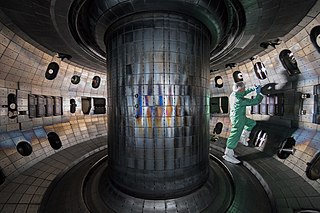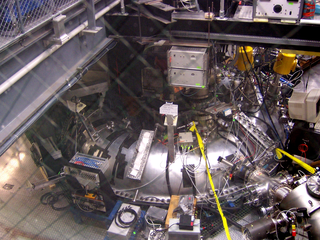Related Research Articles

A stellarator is a device that confines plasma using external magnets. Scientists aim to use stellarators to achieve controlled nuclear fusion. It is one of many types of magnetic confinement fusion devices, the most common being the tokamak. The name "stellarator" refers to stars as fusion also occurs in stars such as the Sun. It is one of the earliest fusion power devices, along with the z-pinch and magnetic mirror.

A tokamak is a device which uses a powerful magnetic field generated by external magnets to confine plasma in the shape of an axially-symmetrical torus. The tokamak is one of several types of magnetic confinement devices being developed to produce controlled thermonuclear fusion power. The tokamak concept is currently one of the leading candidates for a practical fusion reactor.

In plasma physics, plasma stability concerns the stability properties of a plasma in equilibrium and its behavior under small perturbations. The stability of the system determines if the perturbations will grow, oscillate, or be damped out. It is an important consideration in topics such as nuclear fusion and astrophysical plasma.

In fusion power research, the Z-pinch is a type of plasma confinement system that uses an electric current in the plasma to generate a magnetic field that compresses it. These systems were originally referred to simply as pinch or Bennett pinch, but the introduction of the θ-pinch concept led to the need for clearer, more precise terminology.

The Tokamak Fusion Test Reactor (TFTR) was an experimental tokamak built at Princeton Plasma Physics Laboratory (PPPL) circa 1980 and entering service in 1982. TFTR was designed with the explicit goal of reaching scientific breakeven, the point where the heat being released from the fusion reactions in the plasma is equal or greater than the heating being supplied to the plasma by external devices to warm it up.

Magnetic confinement fusion (MCF) is an approach to generate thermonuclear fusion power that uses magnetic fields to confine fusion fuel in the form of a plasma. Magnetic confinement is one of two major branches of controlled fusion research, along with inertial confinement fusion.

A field-reversed configuration (FRC) is a type of plasma device studied as a means of producing nuclear fusion. It confines a plasma on closed magnetic field lines without a central penetration. In an FRC, the plasma has the form of a self-stable torus, similar to a smoke ring.

A spheromak is an arrangement of plasma formed into a toroidal shape similar to a smoke ring. The spheromak contains large internal electric currents and their associated magnetic fields arranged so the magnetohydrodynamic forces within the spheromak are nearly balanced, resulting in long-lived (microsecond) confinement times without external fields. Spheromaks belong to a type of plasma configuration referred to as the compact toroids. A spheromak can be made and sustained using magnetic flux injection, leading to a dynomak.

The Madison Symmetric Torus (MST) is a reversed field pinch (RFP) physics experiment with applications to both fusion energy research and astrophysical plasmas.

The Experimental Advanced Superconducting Tokamak (EAST), internal designation HT-7U, is an experimental superconducting tokamak magnetic fusion energy reactor in Hefei, China. The Hefei Institutes of Physical Science is conducting the experiment for the Chinese Academy of Sciences. It has operated since 2006.

The National Spherical Torus Experiment (NSTX) is a magnetic fusion device based on the spherical tokamak concept. It was constructed by the Princeton Plasma Physics Laboratory (PPPL) in collaboration with the Oak Ridge National Laboratory, Columbia University, and the University of Washington at Seattle. It entered service in 1999. In 2012 it was shut down as part of an upgrade program and became NSTX-U, for Upgrade.
The beta of a plasma, symbolized by β, is the ratio of the plasma pressure (p = nkBT) to the magnetic pressure (pmag = B2/2μ0). The term is commonly used in studies of the Sun and Earth's magnetic field, and in the field of fusion power designs.

The Helically Symmetric Experiment, is an experimental plasma confinement device at the University of Wisconsin–Madison, with design principles that are intended to be incorporated into a fusion reactor. The HSX is a modular coil stellarator which is a toroid-shaped pressure vessel with external electromagnets which generate a magnetic field for the purpose of containing a plasma. It began operation in 1999.

The Tokamak de Fontenay-aux-Roses, TFR for short, was the first French tokamak, built in a research centre of the French Atomic Energy Commission (CEA) in Fontenay-aux-Roses, a commune in the southwestern suburbs of Paris. The project was spearheaded by Paul-Henri Rebut, and is sometimes jokingly referred to as the "Tokamak façon Rebut".
Magnetically confined fusion plasmas such as those generated in tokamaks and stellarators are characterized by a typical shape. Plasma shaping is the study of the plasma shape in such devices, and is particularly important for next step fusion devices such as ITER. This shape is conditioning partly the performance of the plasma. Tokamaks, in particular, are axisymmetric devices, and therefore one can completely define the shape of the plasma by its cross-section.
Compact toroids are a class of toroidal plasma configurations that are self-stable, and whose configuration does not require magnet coils running through the center of the toroid. They are studied primarily in the field of fusion energy, where the lack of complex magnets and a simple geometry may allow the construction of dramatically simpler and less expensive fusion reactors.

In a toroidal fusion power reactor, the magnetic fields confining the plasma are formed in a helical shape, winding around the interior of the reactor. The safety factor, labeled q or q(r), is the ratio of the times a particular magnetic field line travels around a toroidal confinement area's "long way" (toroidally) to the "short way" (poloidally).

A spherical tokamak is a type of fusion power device based on the tokamak principle. It is notable for its very narrow profile, or aspect ratio. A traditional tokamak has a toroidal confinement area that gives it an overall shape similar to a donut, complete with a large hole in the middle. The spherical tokamak reduces the size of the hole as much as possible, resulting in a plasma shape that is almost spherical, often compared to a cored apple. The spherical tokamak is sometimes referred to as a spherical torus and often shortened to ST.

The Princeton Large Torus, was an early tokamak built at the Princeton Plasma Physics Laboratory (PPPL). It was one of the first large scale tokamak machines and among the most powerful in terms of current and magnetic fields. Originally built to demonstrate that larger devices would have better confinement times, it was later modified to perform heating of the plasma fuel, a requirement of any practical fusion power device.

TJ-II is a flexible Heliac installed at Spain's National Fusion Laboratory.
References
- "Self Generated “Bootstrap” Current Contains Magnetic Fusion Plasma" "Archive", General Atomics
- "Plasma Dictionary" "Archive", Nagoya University